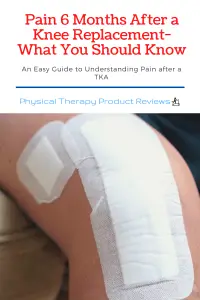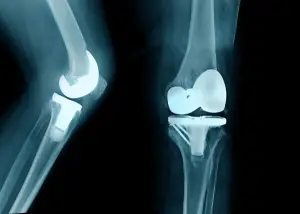 It seems like just yesterday you were being wheeled into the operating room for a total knee replacement. The pain may still feel fresh, but it’s a little over 6 months later. If this sounds like what you’re experiencing, you’re not alone. You may be wondering if this is normal and asking yourself what you can do to combat the pain.
It seems like just yesterday you were being wheeled into the operating room for a total knee replacement. The pain may still feel fresh, but it’s a little over 6 months later. If this sounds like what you’re experiencing, you’re not alone. You may be wondering if this is normal and asking yourself what you can do to combat the pain.
It’s not uncommon for people to experience pain for up to 12 months after having a total knee replacement. If you are one of those individuals, speak with your doctor and physical therapist to see what treatment and therapy options are available to you.
In the meantime, read through these tips and consider following them to help ease the pain.
Getting a Grip on Your Pain
Before we go into more detail on the physical aspects of pain, we should address the psychological impact pain has on our daily lives. When we’re in pain, especially chronic pain, it affects every aspect of our daily life.
Chronic pain is known to cause depression and irritability. Underperforming at work and home due to pain negatively impacts your mood and interactions with loved ones and coworkers. It’s a vicious cycle that can quickly spiral out of control if not addressed. Make sure to monitor your mental health throughout your recovery process.
 Ask for help if you need it and don’t be too hard on yourself. Everyone heals at their own pace Your condition before surgery affects your healing time. Don’t compare your progress with your brother’s friend’s cousin. Talking to someone about how you are feeling can make all the difference.
Ask for help if you need it and don’t be too hard on yourself. Everyone heals at their own pace Your condition before surgery affects your healing time. Don’t compare your progress with your brother’s friend’s cousin. Talking to someone about how you are feeling can make all the difference.
Is Pain Normal 6 Months After a Knee Replacement
It absolutely can be normal to have pain 6 months after a knee replacement. A good rule of thumb is that it takes a full year to recover from a knee replacement.
This all depends on how severe the arthritis was before surgery, how weak the muscles were, and the nerves need to continue to heal, which are slower than muscle or bone to recover.
Should you be concerned that you are still having pain? Not at all. Be confident in the process and give it time to heal. Keep doing your exercises and find ways to stay active.
How to Test Weakness after a Knee Replacement
A simple yet really effective way to test the strength of your surgical leg is to compare it to the other knee. This can be done with a simple step-down test.
Stand at the top of a step and set a timer for 30 seconds. Count how many times you can lower and raise yourself up and down the step in that 30-second span. Perform this on both legs and compare the number of repetitions performed on each side.
Ideally, at 6-months you want the surgical leg to be 85% as strong as the non-surgical leg.
Causes of Pain 6 Months After TKR
The following list is made up of the most common causes of pain 6 months after having a total knee replacement. The vast majority of pain 6 months after surgery is due to weakness and inactivity. The more you can move and try to strengthen the leg the better people feel.
Being Sedentary
Too much time spent on the couch in sitting positions will always cause aches and pain, even if you’re in the best shape. The less you move the stiffer you will become. Keep your body moving even if it hurts a little.
Alignment Issues
Some people argue that the brand of implant used in a surgery affects how well it works; however, if an implant is not installed correctly by the surgeon it won’t matter what brand was used. Implant misalignment can cause things to be out of whack which can lead to a lot of pain. This can be checked on X-rays.

Non-compliance with therapy exercises
Non-compliance is a big issue. People think they can cheat or trick the therapist and say that they are doing their therapy exercises, but the results will show. You can’t fool your body. If you aren’t putting the necessary effort into your recovery, you will get exactly what you put into it. Doing your physical therapy exercises after a knee replacementis extremely important!
Implant Loosening
This is not a very common issue and typically happens after an implant has been installed for years. Most times this occurs with people who live active, high-impact lifestyles.
Infection
Sometimes a small infection can go unnoticed for a long time until it becomes a serious issue. If you’ve been experiencing fevers, swelling or redness then there is a good chance you are fighting an infection.
Patellofemoral Issues
This is just a fancy way of saying something is off with your knee cap. Sometimes an implant may not fit exactly right with the shape of your knee cap. If you are feeling sharp pain as you climb stairs then most likely you have patellofemoral issues that need to be addressed.
Pinched Nerves
Nerves are the worst! While perplexing and fascinating, they can cause a lot of pain. Nerve damage is a tough thing to tackle; the best way to combat pain from nerve damage is to keep moving! Get off your duff and move that body. Massage the areas that bother you as well to stimulate blood flow and hopefully reverse some of the damage. Unfortunately, once a nerve is damaged, it will typically always be that way.
Swelling
It is not uncommon for there to be swelling after having a total knee replacement. You’re putting extra wear and tear on your muscles, ligaments, and tendons that haven’t been used in a long time. It takes time for them to stretch out and adjust.
Ways to Combat the Pain
The following list is made up of different exercises used to build your strength. These can help you work through the pain and may help to relieve it. Remember to check with your physical therapist or doctor before trying anything new.
- Ankle Pumps
- Heel Slides
- Massage
- Pain medication
- Seated Arc Quads
- Seated Knee Extension
- Seated Knee Flexion
- Short Arc Quads (lying position)
- Take anti-inflammatory medication (check with your doctor first)
- Using ice/cold water therapy
- Water Therapy
What Helps the Pain After a Total Knee Replacement
When Pain Becomes Chronic
If you’ve had a total knee replacement over 12 months ago and are still experiencing pain, then chances are you are suffering from chronic pain. You’ll need to find ways to deal with it for the rest of your life. Studies indicate that approximately 20% of people who receive a total knee replacement will deal with chronic pain.
Your doctor and physical therapist can help you create a plan to combat your long-term pain. Keep the lines of communication open and be honest about how you are feeling to get the best care possible.
Don’t Let Pain Control Your Life
Pain can take over your life if you aren’t careful. Keep your mental health in check and stay in touch with your doctor and physical therapist. Work hard, but don’t over-do it.
Sources:
(https://www.ncbi.nlm.nih.gov/pmc/articles/PMC6134884/)
(https://www.verywellhealth.com/pain-after-knee-replacement-2549620),
Other Great Rehab Related Articles
GLP Weight Loss and Back Health: Effective Strategies and Insights
How to Stay Active After Cervical Fractures: Expert Tips and Advice
Dealing with Painful Stairs After Ankle Replacement Surgery
Walking After a Total Ankle Replacement: Tips for a Successful Recovery
Exercises While Non-Weight Bearing After Ankle Replacement: Elevation, AROM, Leg Raises, and More
Ankle Pain with Stairs: Causes and Home Treatment Options
Disclaimer: The information provided in this post is for educational purposes only. This is not a substitute for a medical appointment. Please refer to your physician before starting any exercise program.






